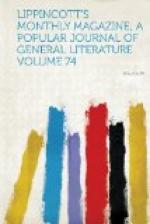[Illustration: CHRIST CHURCH, BOSTON.]
Therefore, the typical New England meeting-house of the seventeenth and eighteenth centuries may perhaps be taken as the best original example of what America has to show in the way of church-building. To be sure, its cost was modest, its material was perishable wood, its architectural design was often a curious medley of old ideas and new uses, and even its few ornaments were likely to be devoid of the beauty their designers fancied that they possessed. But it was, at any rate, an honest embodiment of a sincere idea—the idea of “freedom to worship God;” and it was adapted to the uses which it was designed to serve. It stood upon a hill, a square box with square windows cut in its sides—grim without and grim within, save as the mellowing seasons toned down its ruder aspects, and green grass and waving boughs framed it as if it were a picture. Within, the high pulpit, surmounted by a sounding-board, towered over the square-backed pews, facing a congregation kept orderly by stern tithing-man and sterner tradition. There was at first neither organ nor stove nor clock. The shivering congregation warmed itself as best it might by the aid of foot-stoves; the parson timed his sermon by an hour-glass; and in the singing-seats the fiddle and the bass—viol formed the sole link (and an unconscious one) between the simple song-service of the Puritan meeting-house and the orchestral accompaniments to the high masses of European cathedrals. The men still sat at the end of the pew—a custom which had grown up in the days when they went to the meeting-house gun in hand, not knowing when they should be hastily summoned forth to fight the Indians. In the earliest days the drum was the martial summons to worship, but soon European bells sent forth their milder call. Behind the meeting-houses were the horse-sheds for the use of distant comers—a species of ecclesiastical edifice still adorning the greater number of American country churches, and not likely to disappear for many a year to come.
In the elder day there was no such difference as now between city and country churches, for the limitations of money and material bore upon both more evenly. But with growing wealth and the choice of permanent locations for building came brick and stone; English architects received orders; and the prevailing revival led by Sir Christopher Wren and his followers dotted the Northern colonies with more pretentious churches, boasting spires not wholly unlike those which were then piercing London skies. With costlier churches of permanent material there came also the English fashion of burial in churchyards and chancel-vaults, and mural tablets and horizontal tombstones were laid into the mortar which has been permitted, in not a few cases, to preserve them for our own eyes.
[Illustration: ST. MICHAEL’S, MARBLEHEAD, MASSACHUSETTS.]




